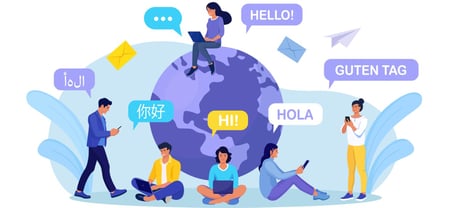5 Considerations for Translating Your Website Into Other Languages

It’s vitally important to translate your website into the languages of your target markets.
CSA Research found that 76% of consumers prefer purchasing products with information in their own language.
So, what languages should your business be looking at? This is a big question, but it doesn’t have to be a daunting one. The answer lies in what is going to get your business the most traction in the new markets you’re heading into while keeping budget in mind.
Once you begin the process of translating your website into other languages, you’ll have a strategy for continuing to add new languages in the future as your expansion needs grow.
At LinguaLinx, we know how important having this foundation is and equally how important it is to put this foundation into action. Of course, there are a lot of considerations to take into account.
In this article, we’ll look at the top four factors that should be reviewed to make this decision. By the end of this article, you’ll have a much better idea of how to choose which languages to translate your website into.
Top 5 Considerations for Choosing Which Languages to Translate Your Website Into
1. What is Your Target Market?
What areas are you expanding into? This is the first, and most obvious, consideration for any website translation project. Once you’ve decided this, you can then look to see what the main languages are that your potential new customers read and speak.
For example, if you’re heading into Chinese markets, are you going to translate into Traditional Chinese or Simplified Chinese? Simplified Chinese is spoken by most people in Mainland China, while Traditional Chinese is spoken largely in outlying areas such as Hong Kong, Taiwan, and Macau.
The right language may not be one you’d anticipate. An example of this is if you’re targeting California, while English is the obvious choice, a study by the Migration Policy Institute showed that only 11% of Californians speak only English.
2. Keep an Eye on the Micro. Localize.
Sticking with the Californian example, we’d always suggest you truly localize your website. Localization is about getting to the heart of the communities you’re heading into and how their cultures operate. Don’t spend all your focus looking at wider geographical statistics.
California has the 5th largest economy in the world, and the Los Angeles economy dominates the state. To move into this huge market, you’d be missing a trick if your website was just in English. According to the Los Angeles Almanac, 38% of people above the age of four speak Spanish as their native language.
3. What's Your Budget?
What budget do you have allocated for website translations? Different languages come with different price tags. There are a lot of factors that influence how much a website translation will cost, such as:
- How many internal resources do you have vs. how many external resources will you need?
- What type of content is on your website? Is it just material that markets your business, or are you running an E-commerce or other type of digital platform?
- What industry are you in? Are there legal ramifications that need to be considered?
- What are your time scales?
- How large is your website?
- What forms of media need translating? Is it just written copy, or do you have to consider audio, video, or other imagery?
4. Website Design
Your website might only be designed for English. It’ll read left to write, so what if you’re heading into a territory that speaks in one of the 12 languages that read right to left like Arabic, Hebrew, Kurdish or Urdu? For these you’ll have to redesign the look of your site to suit the reading shift.
Other languages are considerably longer than English when translated, so this might also be cause for a redesign. Dutch or German, for example, can be up to 35% longer than English.
Imagery and other audiovisual information might need to be translated. If you’re marketing your business in traditional Arabic countries, for instance, you’ll need to make sure that men and women are wearing clothing that doesn’t go against cultural norms.
5. Are There Legal Considerations?
Canada is a great example of this. The country is officially bilingual - English and French speaking - therefore all product literature, advertising and official communications have to, by law, be presented in both languages.
This goes back to considering localization as opposed to just translation. If you’re targeting the province of British Columbia on the west coast of the country, then you have to remain compliant by having a French version, but since it’s largely non-French speaking, you’d actually be better off translating into Mandarin.
And on the central/east side of Canada, in the province of Quebec for example, you’d better not only have a French version of your website, but lead with it.
Get a Quote for Your Website Translation
Hopefully, now you’ve got a route forward to make a strong decision on what would be the best languages to translate your website into. This is a big consideration made, so all you have to do is partner with the right Language Services Provider (LSP) to make that happen.
We’d love to sit down and talk with you about this, as we have extensive experience helping businesses of all sizes move into new territories.
Consultations are free and there’s no obligation.
And if you’re still unsure, let’s have a chat. We can add some flesh to the bones of what is discussed in this article while answering your questions and making sure the conversation is contextual to your business.
With LinguaLinx, you won't ever have to worry about your message getting lost in translation. You know you're in good hands with our ISO 17100 and ISO 9001 compliance, twenty years of professional translation experience, and the organizations whose trust we've earned.






